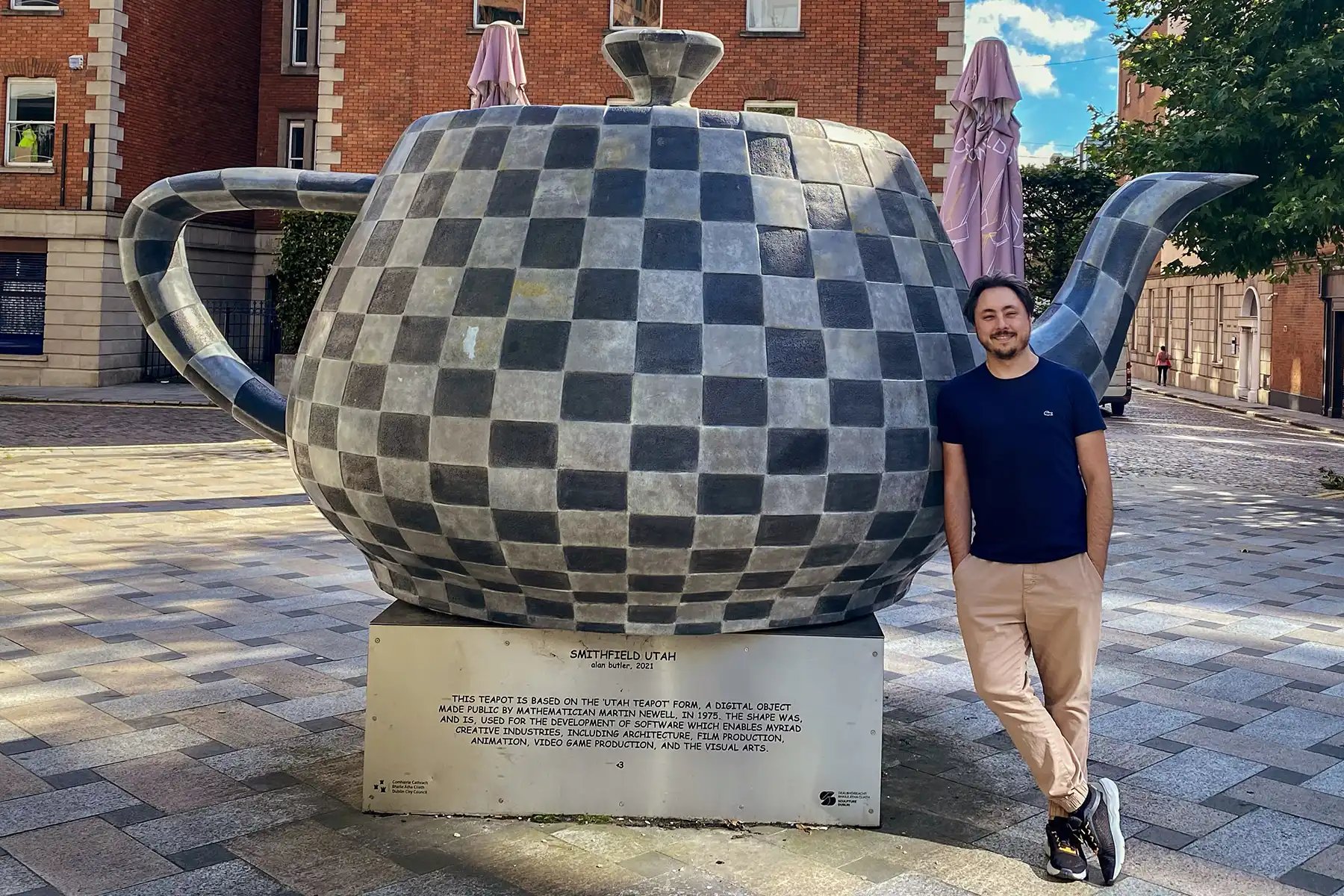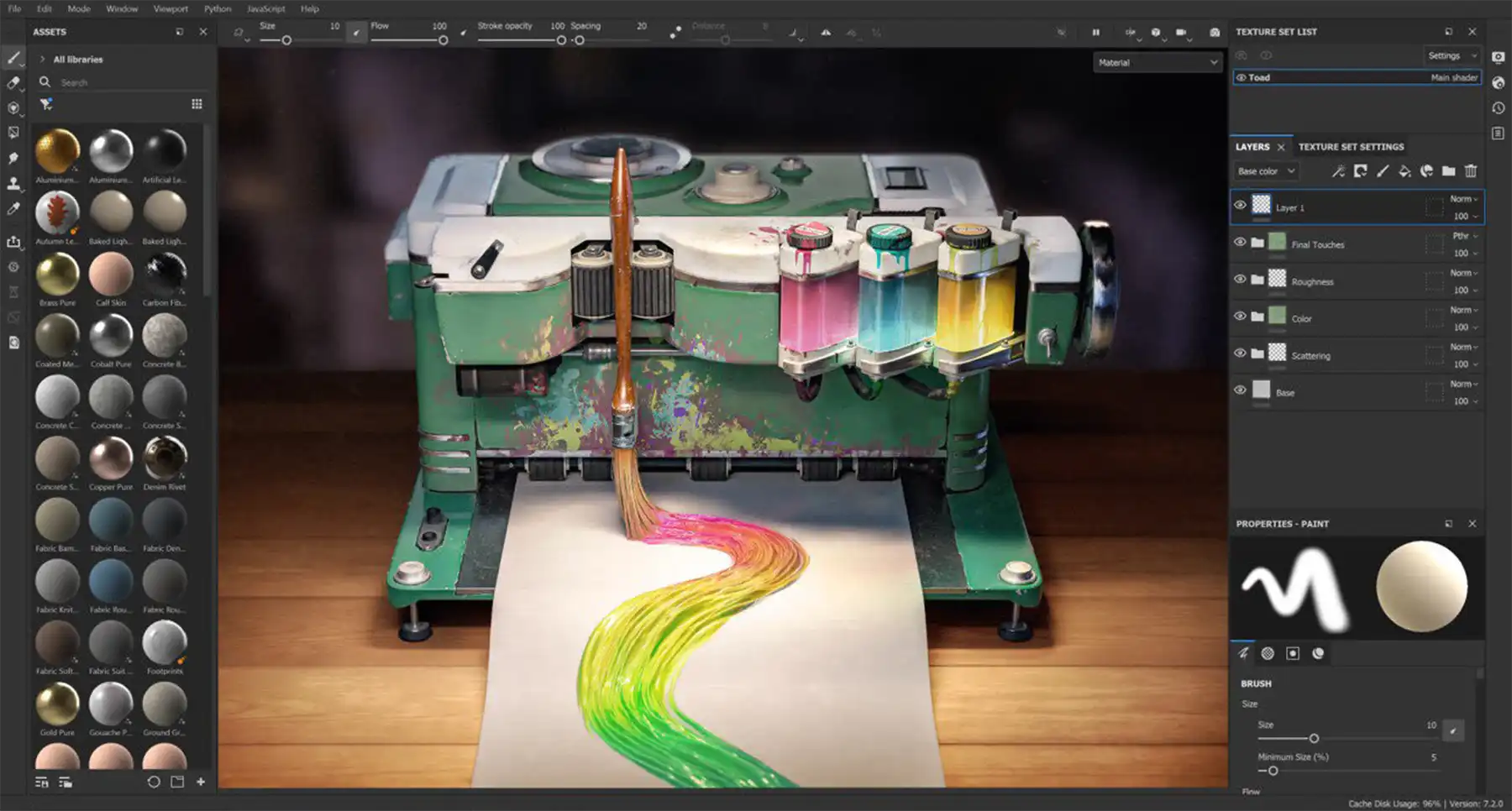Talking about 3D graphics with Eduardo Righi Chaves can quickly take a poetic turn. “Rendering is this beautiful cross between art, physics, programming, and mathematics with a dash of biology and human nature,” the 2016 BS in Computer Science in Real-Time Interactive Simulation (RTIS) graduate says, reflecting on a discipline that has taken him around the world — from his native Brazil, to DigiPen’s Redmond campus, to his current home in Paris. That’s where he now serves as the lead computer graphics engineer at creative software titan, Adobe, working across the company’s wide spectrum of Creative Suite applications. Whether it’s Substance, After Effects, Aero, Illustrator, or Photoshop, if an Adobe product has 3D capabilities, Chaves and his team develop the rendering technology and architecture that supports it.
Even as a child, Chaves always led the charge in making 3D graphics happen. “I got into game development at a young age, and at that time there weren’t any commercial game engines freely available to the public, so the only alternative was to create my own,” Chaves says. “I liked all aspects of the process, but graphics programming in particular became my favorite part.” With only two game studios in his hometown of Belo Horizonte, Brazil, Chaves decided to sideline his passion for games, graphics, and computer science to pursue an electrical engineering degree instead, a hard decision made out of practicality. But fate had other plans.

Not long after starting the degree, Chaves pitched the creation of a C++ programming course to his former high school to be taught through game development and robotics. To his surprise, his proposal was accepted, and he was hired on as the course instructor. Two years later, Chaves saw a post on a Brazilian game development forum about a job opening at one of those two game studios in his hometown, Ilusis Interactive Graphics. “I decided to show up there unannounced and give them my resume in person,” Chaves says.
The gambit worked. Ilusis hired Chaves, where he spent two years diving into the game industry. “Being part of a small studio meant that I had to wear many hats, from coding gameplay to tooling with the core engine, and that gave me the confidence to search for a computer science program focused on game development,” Chaves says. After a thorough search didn’t turn up any degrees dedicated to game programming in Brazil, Chaves decided to look abroad and found the “perfect program” he was looking for at DigiPen. “I dropped out of electrical engineering and started my RTIS degree,” he says.
At DigiPen, Chaves quickly found himself jumping right back into graphics programming and custom game engines, eventually crafting his original “Mocha Engine.” The feature-heavy engine enabled Chaves’ student game team, Team Mocha, to create their junior-year project, Sunder, which won an IndieCade Audience Choice Award in 2014 for its innovative concept. A co-op puzzle platformer, two players look at the same screen but see completely different things based on red or blue color-filtering glasses they each wear, requiring close verbal communication to progress.
Created the following year, the game’s spiritual successor, Subject REDACTED, took the asymmetrical co-op idea even further. A survival horror game about escaping a mysterious, hazard-filled facility, one player on a computer must safely navigate through while player two, wearing a VR headset, monitors surveillance cameras and communicates crucial insights on incoming threats and obstacles.
Both games’ unique cooperative gameplay also happened to embody some of the major lessons Chaves says he took away from his time at DigiPen. “Working together is crucial, and so the project management, teamwork, and soft skills I developed with my game team over the years at DigPen are essential to my daily work today,” Chaves says. “The hard skills I learned during my time at DigiPen are certainly important and helped me get hired in the roles I’ve always dreamed of. However, with experience came the realization that software development is as much of a human science as it is a hard one.”
At Adobe, that team-oriented, human-centric approach to software development has proven invaluable in Chaves’ role as a lead computer graphics engineer. “My role as a lead is first and foremost to make sure my team has everything they need to be able to work effectively,” Chaves says. “I’m lucky enough to work alongside industry veterans with decades of experience in the animation, VFX, and games industry here, and I’m constantly learning from them.”
A game industry convert himself, Chaves landed at Adobe somewhat unexpectedly after working as an engineer at Nintendo and Unity Technologies out of DigiPen. In 2018, ready for the next step in his career and craving a position with an even deeper focus on 3D rendering, Chaves initially limited his job search to the game industry. “At the time, all I knew was that Adobe dealt mostly with 2D graphics, which was not within my area of expertise,” Chaves says. “One day, however, my wife found this job opening, and it turns out that Adobe was hiring 3D graphics engineers to develop a new rendering engine to power an augmented reality project that ended up becoming Adobe Aero.”

The job was exactly what Chaves was looking for, a role that quickly grew in scope as Adobe’s focus on integrating 3D tools and features into its popular Creative Suite snowballed. Just a year after Chaves was hired, Adobe acquired the French company behind Substance, a powerful suite of software tools for creating 3D textures, objects, and materials that are widely used in the AAA game industry. “The U.S. and French teams were both working with 3D rendering and naturally started converging,” Chaves says. As someone who had long wished for an opportunity to one day live in Europe, Chaves seized the opportunity and transferred to Adobe’s new offices in France, initially landing in Lyon before his current home base in Paris. “There was an initial learning curve picking up the language and understanding the culture, but today we’re fully accustomed and we love it here!” Chaves says.
Adobe’s robust Creative Suite features over 20 applications that users can employ in a vast array of unique workflows to suit their own needs. One of Chaves’ major work challenges is simply ensuring the growing number of Adobe applications with 3D capabilities all work together smoothly across platforms and devices. “We strive to provide a unified experience across all client applications with the highest possible fidelity, while at the same time adapting to each application’s rendering pipeline and requirements,” Chaves says. “This in and of itself is no easy feat, but on top of that we are constantly trying to push the state of the art in rendering. Finding the balance between innovation, stability, reach, and development throughput is a constant challenge.”
To me, the most rewarding part of the job is finally finding the perfect solution to a problem I initially thought was impossible to tackle given the requirements.
As a technical lead, Chaves is often at the forefront of that push to pioneer new 3D tech, both on his own team and alongside the larger Adobe research group. Whether it’s using machine learning to “denoise” grainy artifacts in renders, developing new methods for rendering real-time shadows and complex transparencies, or partnering with Autodesk and MaterialX on the new “OpenPBR” project to improve the interoperability of 3D projects across all industry software, Chaves is often in the trenches coding new features and pushing the boundaries of rendering technology.
“3D rendering is a vast field with a variety of applications that will evolve differently depending on what problems you’re trying to solve,” Chaves says. “To me, the most rewarding part of the job is finally finding the perfect solution to a problem I initially thought was impossible to tackle given the requirements.”
Just like in his DigiPen student games, Chaves says a little bit of co-op goes a long way toward finding solutions to those impossible problems. “The way I overcome these obstacles is, honestly, by relying on the amazing team I am fortunate to be part of,” Chaves says.
